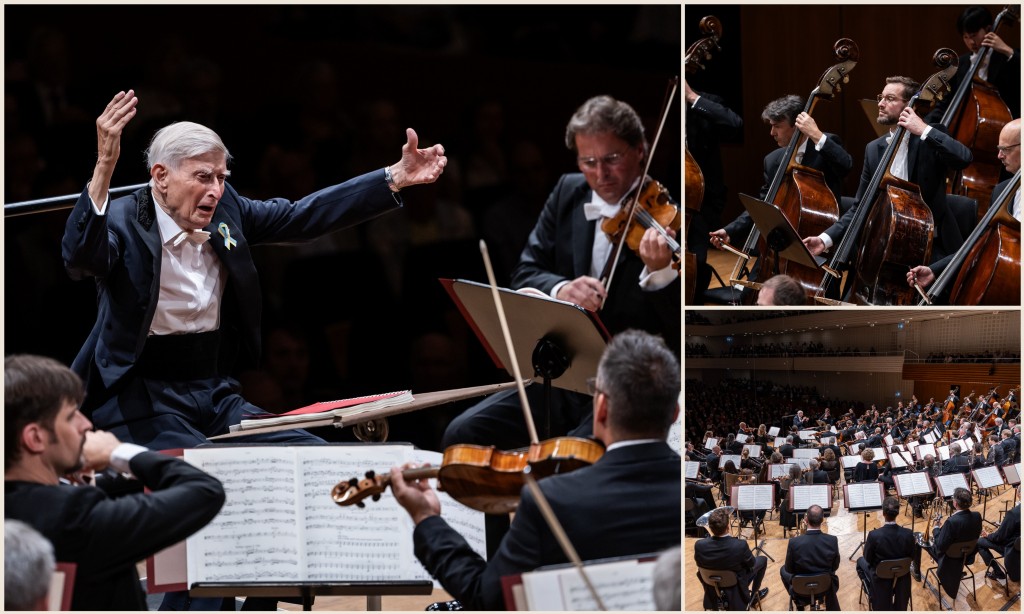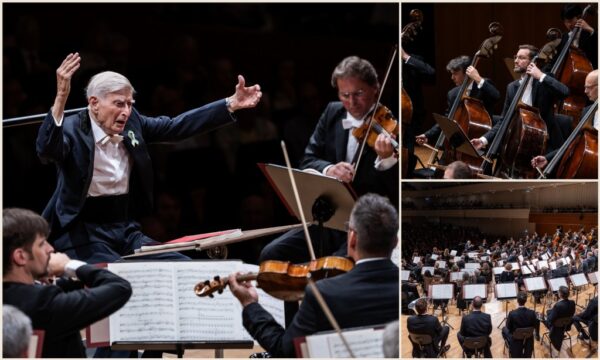“More than any other composer, Bruckner excels in the art of musically
depicting the infinity of time and space” (Herbert Blomstedt)
depicting the infinity of time and space” (Herbert Blomstedt)
A cerulean clarity, the azure transparency of the mountains of Upper Austria, with the indescribable melancholy of the end of summer… This is how the tremolo of the violins in the first movement of Bruckner's Seventh Symphony elevates the listener towards open and grandiose heights. Herbert Blomstedt, 96, seated, gracefully sculpts this sonorous cathedral, the most famous and accessible of all the symphonies by the Master of Saint Florian. This evening, he offers the new critical edition of the score recently published by Paul Hawkshaw. We can be satisfied with this philological choice – even if Blomstedt kept the cymbal stroke of the climax of the Adagio (subject of many musicological quarrels!) – because Paul Hawkshaw spent years in Vienna studying the autograph manuscript of the Seventh. Tonight we hear the symphony as it sounded when it received a stunning triumph on December 30, 1884 in Leipzig. We are immediately captivated by the light texture of one of the most prestigious Brucknerian orchestras in the world, the Gewandhaus Orchestra, while Bruckner’s music still sometimes suffers from a reputation for massive heaviness. This is not the case here, and Blomstedt is certainly today the best ambassador of this composer, to whom he knows how to do justice, by his philological probity, but also now, his spiritual commitment, his lofty view, in a word : his wisdom.
Blomstedt's Bruckner breathes, he is lightened, even juvenile: you have to see how the conductor arrives at his desk, with a playful, sometimes mischievous eye. It places us far from the pasty romantic Bruckner so much criticized in our regions, where his presence at concerts is still too rare. Adopting a giusto tempo (Allegro moderato), Herbert Blomstedt knows how to be vehement and sometimes epic, helped by powerful brass instruments with exemplary performance. It is striking to see how the conductor obtains absolutely everything from his musicians through economy of means, sober gestures, which is not antithetical to beautiful expressiveness, and even a certain lyricism. The conductor places himself at the service of the music, closed score placed on the desk, mastering the smallest nuances which he obtains by his sole presence: Brucknerian conductors of this stature, there was Bernard Haitink or Günter Wand, who knew that it takes a lifetime to achieve such a degree of humble simplicity, an economical eloquence and humility that serve the work and its composer. With the Leipzig Gewandhaus Orchestra, very distinguished, we are both in the beauty of sound, as evidenced by the silky strings, and the taking of risks, the huge power, close to the Berlin Philharmonic sound.
But above all we are surprised by the Wagnerian dimension of the vision proposed by Blomstedt: this symphony should receive the nickname generally associated with the Third Symphony, the “Wagner Symphony”. The woodwinds and brass are balanced, the intimate landscape of certain pages of the Ring is indeed present, particularly in the use of the clarinet and the oboe (but certainly not the English horn). We move from the rustling of the forest to the glorious brassy tutti, notably the organ point in E major, a grandiose zenith executed with exhilarating and imposing majesty.
The first movement of the Seventh Symphony was finished in July 1882 when Bruckner went to the premiere of Parsifal, where he had noticed the exhausted health of the composer of Tristan. Thent he began to compose the Adagio, as if he had had a premonition of the approaching end of the man who was in fact going to die in Venice: “one day, I returned home very dejected; I felt that the Master had not long to live: and the Adagio in C sharp occurred to me", wrote Bruckner in a letter of May 1885. The influence is manifest, since Bruckner inserts a quartet of Wagnerian tubas for the first time in his symphonic work. With Blomstedt, here is an Adagio full of this beautiful shimmering light, bursts of warm luminosity behind the stained glass windows of a wonderful cathedral, assuming its homage to the Master of Bayreuth, but without excessive pathos. We are more in the nostalgic lullaby of A German Requiem by Brahms. The conductor maintains a certain velocity, without languishing the line, drawing like waves, flows, in a beautiful gesture with his right hand. Nothing elegiac therefore at the beginning, but a palpitation, the percussions modestly punctuating the beats of a sad soul. The whole is of haughty elegance and confusing beauty. The orchestra bends perfectly to the intentions of the conductor, playing here on calm, rest. Blomstedt simply knows how to pay attention to the richness of the score and its multiple legacies. At the end of the Adagio, something hollows out, deeper, and in a more jerky gesture, the conductor again obtains a brass tutti, brilliant and imposing ; the orchestra is then adorned with a heroic brilliance, a true apotheosis of a funeral march, aided by the famous cymbal stroke and the tremolo of the triangle. From the murmurs of the forest (in E major, like the symphony!) to the spectacular bonfire at the end of this movement, the audience is invited to an exciting sound journey, guided by Wanderer Blomstedt. The movement ends in a vaporous solo of flute (what grace!) and pizzicati, joined by the melancholy tubas which take up the initial complaint, in a serene alpine atmosphere which guides the Master to the sky of the idols. We do not forget that the dedicatee of the Seventh Symphony was Ludwig II of Bavaria…
The third movement, Scherzo, breathless, offers a real contrast, a race towards the abyss, even a Purgatorio. We hesitate between the popular air of the Ländler characteristic of Brucknerian writing and the sardonic questions about the afterlife, in tortured visions which anticipate the mechanistic sound and fury of the Ninth Symphony. With Blomstedt, the relationship with the famous Ride of the Valkyries becomes obvious, even if the rhythms (ternary for one, binary for the other) and the structure differ, there is nevertheless something of the order of the cavalcade limping post-mortem of female warriors bringing back the souls of valiant heroes who died in battle, notably in the strong sounding of trumpets. The violins spare no effort : the physical commitment is total, the bows struggle, the knowing looks and movements of the musicians show the faith they put in the execution of this literally exhausting page.
After the Dantesque crossing of the shadows of the Scherzo, here is the light of the beginning of the symphony (same key of E major), in a form of relief, crossed by some languidness of Venusberg, vital driving force, which marks the victory of the music on death. Paradise is there, opening its doors. Blomstedt's Bruckner is fascinating because of the dynamic he instills, far from the marmoreal hieraticism of the Klemperer of recent years or the Himalayan infinities of a Celibidache. Here, the progression is constantly supported by the strings, in a movement reminiscent of the Wanderer's march. It is indeed a journey, even a spiritual quest.
The balance is perfect, in put it in a nutshell : Blomstedt captures the mixture of spiritual serenity and epic specific to this symphony in a hymn to music with triumphant accents, everything ends with a new apotheosis, provoking an amazed and collected silence before the deserved standing ovation. We must then see with emotion the Maestro, guided by his first violin, return four times to greet, radiant, and with an eye always mischievous, an audience won over and admiring the art of the master, with his beloved orchestra, in a new Lucerne evening where the heart of music beats before half-opening the doors of Valhalla : we look forward to the bicentenary of Bruckner's birth in 2024!
Philippe Rosset
September 1st 2023
September 1st 2023



